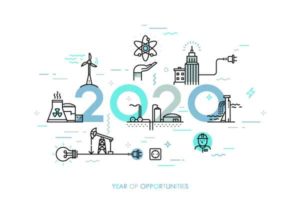
Manufacturing Industry Outlook 2020: Step Forward or Back?
January 27, 2020
It’s an election year, the United States and China have been “locked in a bitter trade battle” and articles of Impeachment have been brought to the Senate. Is it any wonder that there’s uncertainty in the economy?
In an attempt to unravel this ambiguity, let’s see how OEMs wrapped up 2019 and take a look at the factors likely to impact the sector outlook in 2020.

Even as the overall economy grew for the 128th month in a row, according to ISM, only three of the 18 manufacturing industries studied by the Institute for Supply Management (ISM) in December 2019 experienced growth: Food, Beverage, and Tobacco products.
The ISM’s latest Manufacturing Report On Business registered many decreases. The December purchasing manager’s index (PMI) registered 47.2 percent, a 0.9 decrease from November’s 48.1 percent. This was the PMI’s lowest since June 2009’s 46.3 percent, and marked nine straight months of softening or contraction in manufacturing.
The ISM Report also noted:
- The New Orders Index declined 0.4 to 46.8 percent
- The Production Index was down 5.9 percentage points to 43.2 percent, and at its lowest reading since April 2009’s 36.7 percent
- The Employment Index dropped 1.5 to 45.1 percent
- The New Export Orders Index decreased 0.6 percent to 47.3 percent
Meanwhile, the Supplier Deliveries, Prices, Inventories, and Imports Indexes registered some increase. But that’s not necessarily a good thing, as ISM chair Timothy R. Fiore noted, “Supplier deliveries continue to become more difficult.”
Inventories registered 46.5 percent (+1). This represented companies’ continued efforts “to match raw-material inputs with new-order receipts and backlog status,” according to Fiore.
The December 2019 Imports Index was 48.8 percent (+0.5). The Backlog of Orders Index also rose — up 0.3. — to 43.3 percent.
Taken together, these results indicate contractions in demand and consumption. Import contraction “eased slightly” while inputs “expressed as supplier deliveries, inventories and imports — improved in December,” according to ISM’s statement.
Fiore registers one positive for 2020: Prices increased for the first time since May 2019. Prices came in at 51.7 percent (+5), as manufacturers placed orders for steel, copper, and aluminum for 2020 demand.
Uncertainty in Manufacturing Industry Outlook
Deloitte also weighed in with its 2020 Manufacturing Industry Outlook “to help leaders navigate uncertainty and increase operational flexibility for the future.” But what threatens manufacturing industry resilience?
- Continued risk for disruption
- Muted job growth and difficulty filling critical jobs
- Ongoing uncertainty in tariffs and their subsequent impact on trade flows
As of April 2019, the U.S. government had collected $22 billion in tariffs for the year, an increase of 78% from prior years. — American Farm Bureau
Ultimately, Deloitte anticipated a “mixed view of the sector” in 2020. In the 2018 Manufacturers’ Outlook Survey report, “93.9 percent of manufacturers had a somewhat or very positive outlook on business.” But the 2019 iteration found only 67.9 percent reported optimism.

Facing continued cost volatility and price uncertainty, manufacturing must also adapt to the new Marpol Annex VI fuel regulation, which went into effect January 1. Addressing air pollution from ocean-going ships by limiting emissions of sulfur and other contaminants, the regulation is expected to increase shipping costs. Logistics costs could also rise due to the electronic logging device mandate’s increasing pressure on trucking and the shortage of drivers.
“In 2018, trucks moved 11.49 billion tons of freight, 71.4% of the nation’s tonnage freight.” — American Trucking Association
2020 Manufacturing Industry Trends
After looking back at 2019, it’s time to look ahead to 2020. One trend everyone agrees will have an impact? The continuance of manufacturing momentum to make digital progress. Leveraging artificial intelligence, cloud computing, advanced analytics, robotics, and additive manufacturing could support greater supply chain transparency and agility.
Forward-leaning manufacturers will also be seeking partners to create new customer value and enhance customer stickiness. Further, Deloitte expects the sector’s digital muscling up to play out in shifts in sourcing, improving risk management, as well as driving higher productivity and outputs in smart factories.
Metal fabricators will also leverage new technologies. Tube laser technology, for instance, is enabling companies to speed up fabrication while saving money and producing more precise cuts and reducing downstream assembly downtime.
The metal fabrication industry is also expected to keep growing overall, not just in 2020. The global market share of metal fabrication was valued at $68.36 billion in 2017. Grand View Research anticipated the market size to expand at a CAGR of 3.90% until 2025.
Further, almost 60 percent of the respondents to Fabricators & Manufacturers Association, International® (FMA)’s “2020 Capital Spending Forecast” expect higher operating levels. Larger fabricators, that serve global OEMs, foresee 2020 to be “somewhat flat.”

“We have sectors that are booming. And we have sectors that are in decline, and ones that are in the middle. The declining ones are those sectors that are most connected to the global economy,” said FMA economic analyst Chris Kuehl.
And that election we mentioned? We’re likely to see manufacturers “pushing pause” and taking a step back to rethink technology purchases, supply chain, and material purchasing strategies.
Industrial Fabrication Forecasting
Companies in the automotive sector, in particular, are re-evaluating their supply chain footprints. Tariffs are compounding the challenges of trying to manage risk, according to the Center for Automotive Research (CAR). In forecasting 2020, it offered two outlooks. One, in which nothing changes with tariffs, and another if imported vehicles and parts tariffs go into effect.
The tariffs would “have substantial negative impacts,” Bernard Swiecki, CAR’s assistant director of research, told The Fabricator. “The average U.S.-built vehicle would be about $2,000 more expensive and the average import about $3,700 more expensive,” Swiecki said. “We believe this would reduce sales by 1.2 million units and take about 368,000 jobs out of the economy.”
Another area getting attention? Capital spending. FMA notes the United States Department of Commerce reported a capital spending decline of about 4% in November 2019. Yet, FMA projects equipment spending to be $2.76 billion in 2020 (only slightly above 2019’s $2.75 billion projection).
Certain equipment categories are also “seeing truly massive gains.” Fiber laser cutting machine spending leaped more than 40% higher than 2019 projections. FMA expects the category to hit $275.6 million in 2020. Thanks to the increased throughput from the fiber laser, press brake spending also reached record highs, “with 2020 projections jumping a full 50 percent, to $252 million.”
Eric Miller, president of Miller Fabrication Solutions, also shared his own perspective with The Fabricator. “I expect the first half of the year to be slow, but based on what we’re hearing, both from our customers and from general economic indicators, we feel the second half [of 2020] will be very strong.”
It all comes down to “good partnerships,” he said. “If we have a good working relationship with suppliers and customers, we can all work together and approach problems with an open mind.”